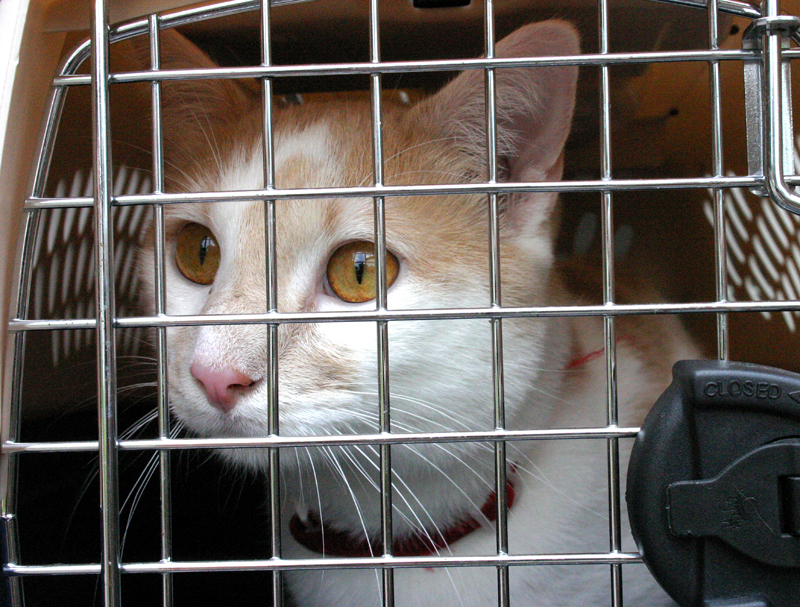Riding in style: How to choose the right carrier – and get your cat to like it!
As a rule, cats and carriers go together like… well, like marshmallows and mustard. Anyone who has tried to coax a reluctant feline into his carrier will agree. In a way, it’s understandable. Most felines don’t appreciate being shut in a strange box and then carted off somewhere against their will. But it doesn’t have to be that way if you choose the right cat carrier and take steps to ensure she’s comfortable with it.
Buying the right one
There’s a huge variety of animal carriers on the market these days, and increasingly innovative designs are appearing all the time. They range from the familiar plastic kennels to lightweight carriers made of fabric nylon in all kinds of styles and colors. Some models can be trundled along on wheels like a baby stroller, while others can be carried hands-free on your front or even slung over your shoulder like a bag. Here’s what to keep in mind when shopping for a cat carrier for your own kitty.
- A cat’s first reaction, when she finds herself in a strange situation, is to try and escape. Look for a cat carrier she can’t easily tear or push her way out of.
- Shop around and look for sturdy, good quality materials. It’s better to pay more up front and get something that’s safe and durable.
- Check the cat carrier over carefully before each use, to ensure no parts are loose or gone. A missing bolt or loose door can lead to your cat breaking out in a strange place and getting lost or injured.
- Size is an important factor. Contrary to popular belief, many cats prefer small carriers to larger ones because they feel more secure. Just makes sure it offers enough room for the cat to stand up, turn around, and stretch out in.
- Look for extra features, such as attachable containers for water or food. These aren’t really an issue for short trips, but are essential if you’re traveling any distance with your cat.
- Make sure the cat carrier has proper ventilation and a way for your cat to see out, while also offering her a sense of safety and privacy. There should be no protruding pieces of hardware or plastic that could cause injury. If you’re planning to take your cat long distances, some form of insulation may also be a consideration.
- Help your cat feel comfy by giving her something soft to lie on. A cloth bed or pad is best because it gives her something to hang onto and won’t slip like a blanket or pillow. A number of companies offer special inserts or pads that are waterproof as well as comfortable, so if the cat has an accident, she’s not forced to sit on a damp surface.
- Most cats are too distracted to play with toys while in their carrier, so there’s not much point putting any in, unless you’re taking your cat on a longer trip. After a few days, she may settle down enough to play a little.
Familiarity breeds comfort
One of the biggest problems people encounter is getting their cats inside the carrier. Many felines either run and hide as soon as they see it, or become an awkward bundle of claws when you’re trying to insert them through the door. The best solution is to acclimatize your cat to the carrier before you actually use it. If you only get it out for trips to the vet, for example, your cat will quickly come to associate it with an unpleasant experience, so it’s only natural for her to hightail it whenever she sees you pulling it out of storage.
Try leaving the cat carrier on the floor in plain view with the door open, so she’s encouraged to climb into it of her own accord. A cat loves getting inside paper bags and cardboard boxes, and will come to treat her carrier the same way if it’s presented in a non-threatening manner. Placing a favorite toy or some healthy treats inside the carrier will provide further enticement. You can also try playing “hide and seek” with her while she’s exploring the carrier, to further help her associate it with something enjoyable.
If you have to quickly transport a cat that isn’t used to a carrier, try this four-step procedure.
- Stand the cat carrier on its end, so the door is facing upwards.
- While comforting the cat in a reassuring tone, lift him gently in both hands and lower him into the carrier feet first until he’s completely inside.
- Close and secure the door before he attempts to jump out.
- Slowly and gently right the cat carrier, while continuing to offer verbal reassurance.
Cool cat carriers
Looking for a unique cat carrier? Here are just two examples of what’s out there.
The Sleepypod from Meowme is designed to be a bed as well as a carrier, which means it’s easy to train your cat to enjoy it. This award-winning product has a removable mesh dome top and a plush interior. It’s constructed from lightweight luggage grade nylon and comes in five colors. www.sleepypod.com
For those who find it difficult to lift a carrier, a Kittywalk Pet Stroller might help. They come in a several designer styles and give your cat plenty of space to move around in. They’re collapsible and lightweight for easy storage and transport, and handcrafted from durable quality materials, such as escape and rip-proof netting. www.kittywalk.com







No Comment